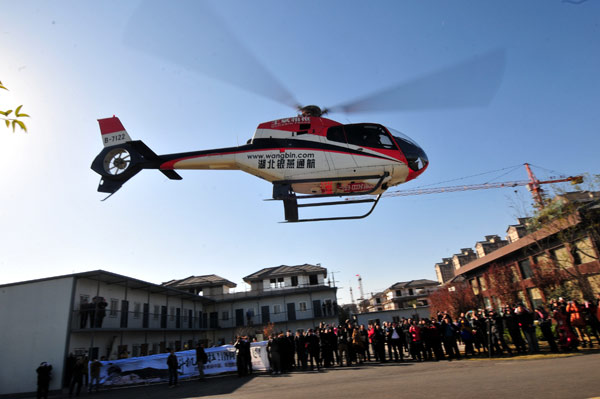
3 Dec, 2013
China’s General aviation sector ‘set for takeoff’
Beijing 2013-11-30 (China Daily) – The general aviation industry in China is poised for a boom, with the authorities encouraging its development, but the money pouring into the sector may lead to a bubble, industry experts said.
The Civil Aviation Administration of China and the General Staff Headquarters of the People’s Liberation Army jointly released regulations on Nov 18 concerning general aviation, a move that’s giving a lift to these flights.
General aviation consists of non-scheduled civilian flights.
Under the regulations, general aviation flights that don’t affect national security will be subject to approval by the CAAC, not the military. In some cases, operators will only need to file a flight plan rather than seek specific approval.
|
 A helicopter takes off in Luoyang, Henan province. Some local governments are seeking a piece of the action by building general aviation industrial parks. [Photo / China Daily]
|
“The regulation will improve the development of general aviation, but we are still waiting for the real opening of low-altitude airspace, which means more space for general aviation aircraft based only on filing flight plans, no approvals,” said Gao Yuanyang, director of the general aviation industry research center at the Beihang University.
Contracts worth 22.9 billion yuan ($3.7 billion) were signed during the China International General Aviation Convention 2013, which was held from Oct 17-20 in Xi’an, Shaanxi province.
But that’s just the tip of the iceberg, as China’s general aviation industry is expected to exceed 1 trillion yuan per year eventually.
Some local governments are already seeking a piece of the action by building general aviation industrial parks.
Statistics from the Aircraft Owners and Pilots Association of China show that as of July 30, there were 116 cities above the county level that were building or planning general aviation industrial parks.
That’s in addition to the 10 State-level aviation high-tech industrial bases approved by the National Development and Reform Commission, the country’s top economic planner.
However, some experts warn that investment is already overheated, and some general aviation parks without any advantage in technology, facilities or staff will end up being just more real estate projects.
“The industry has a critical shortage of general aviation airports, but it’s not necessary to develop airports into industrial parks,” said Gao. “Reckless construction of the parks will have an adverse effect on the industry.”
He Liang, director of the Xi’an Yanliang National Aviation Hi-tech Industrial Base’s administration committee in Shaanxi province, also expressed concern.
“Like the booming in the vehicle industry in the early 1990s in China, overheated construction of general aviation parks will also lead to a downturn, and some facilities without the necessary technological and industrial conditions will fall into disuse,” He told China Daily.
He’s base, established in 2004, aims to create an entire industry chain, including the major industry of aircraft manufacturing, production of aircraft engines and aviation activities, He said.
More than 500 aviation enterprises and supporting companies have been established at the base.
Private capital is surging into the industry, with 178 general aviation enterprises around the country as of June, 32 more than at the end of 2012.
But some general aviation aircraft manufacturers said that their business isn’t yet improving.
“Our sales have even gone down recently, since new operators only need one or two planes for appearances,” said the marketing director of a helicopter builder, who declined to be identified.
It’s quite possible that some companies are only trying to gain something from various governments’ preferential policies for the general aviation industry, he said. Some companies are even just trying to get land in the industrial parks, he added.
“We’ll need to wait for a long time before the industry really booms,” he said, adding that he remains optimistic about the outlook for the sector.
As of June 30, there were 1,610 registered general aviation aircraft in China. The total flight time of general aviation will be more than 600,000 hours in 2013, 80,000 hours more than last year, according to the CAAC.
Compared with some 230,000 general aviation aircraft in the United States, there’s huge market potential in China, said Gao.
The State Council, China cabinet, issued a document on promoting the development of civil aviation industry in July 2012, which said that emerging general aviation services such as private and business flights should be greatly developed.
“The total number of general aviation aircraft is expected to be more than 10,000 within five to 10 years,” Gao said.
Some experts suggested that more general aviation airports should be built, while controlling the number of industrial parks.
China only has some 100 general aviation airports at present, and 70 of these are registered with the CAAC, said Wang Xia, deputy dean of the general aviation college of the Civil Aviation University of China.
These airports can’t meet the huge market demand, Wang said. The small number of general aviation airports is a major constraint on the industry, she said.
“China now has no national standard for the construction and management of general aviation airports, and it urgently needs to develop uniform standards for the industry’s management,” Wang added.
He Liang, the director of the industrial base in Shaanxi, said that his base will work jointly with other government departments to build five or six general aviation airports in the province. The base also aims to establish a low-altitude network with more than 10 airports for general aviation in the province in the coming decade.
“We plan to open a general aviation air route from Neifu airport in Pucheng county in eastern Shaanxi to Hengshan airport in northern Shaanxi in 2015, which could be a commuter route or tourism route,” He said.



Liked this article? Share it!